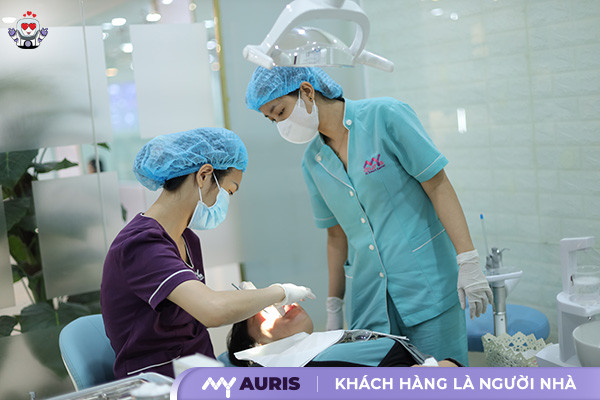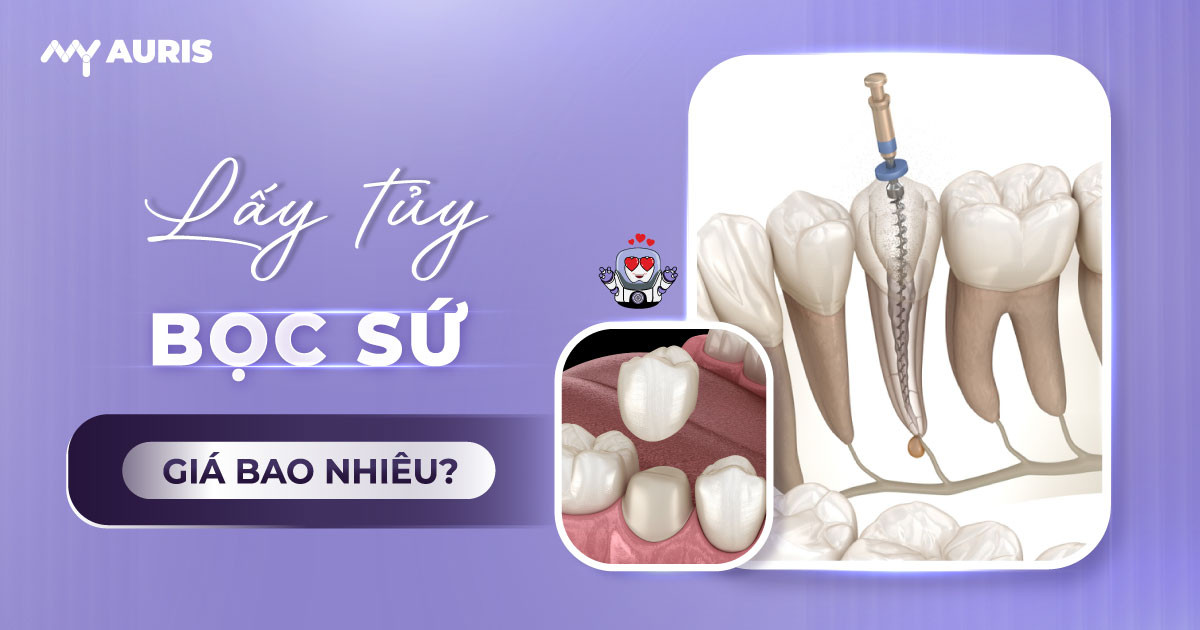Tủy răng đóng vai trò thiết yếu trong việc duy trì sức khỏe răng và bảo vệ chức năng răng. Tuy nhiên trong một số trường hợp, việc lấy tủy là cần thiết để điều trị tổn thương, giúp quá trình phục hình răng đạt hiệu quả tối ưu. So after a root canal, will porcelain crowns cause pain? Price for porcelain crown after root canal? Cùng tìm hiểu để có sự chuẩn bị tốt nhất khi lựa chọn phương pháp thẩm mỹ răng này!
Lấy tủy bọc răng sứ giá bao nhiêu?
Chi phí cho dịch vụ này không cố định mà tùy thuộc vào nhiều yếu tố như loại răng sứ, tình trạng sức khỏe nướu, chất lượng răng sứ, cơ sở nha khoa và tay nghề bác sĩ nha khoa.
Hiện nay, giá bọc răng sứ sau lấy tủy dao động từ 2.000.000 – 4.000.000 đồng/răng, cụ format:
- Răng sứ kim loại: Từ 2.000.000 – 2.500.000 đồng/răng
- All-porcelain teeth (Ceramic, Zirconia, Emax…): From 3,000,000 – 4,000,000 VND/tooth
In addition, some dentists may separately calculate the cost of root canals and scalpels. động từ 500.000 – 1.500.000 đồng/răng, tùy vào mức độ viêm nhiễm và độ khó của ca điều trị.
Benefits of root canal before porcelain crown
Trước khi tìm hiểu về chi phí lấy tủy bọc răng sứ, chúng ta cần hiểu rõ tủy răng là gì và tại sao cần lấy tủy trước khi bọc răng sứ.
Tủy răng là gì?
Dental pulp is an important part of the tooth structure, located deep inside and protected by enamel and dentin. Nó chứa mạch máu, dây thần kinh và tế bào nhân tủy, đóng vai trò cung cấp dinh dưỡng, duy trì sự sống và chức năng của răng.
Cấu trúc của tủy răng gồm:
- Men răng: Lớp ngoài cùng, giúp bảo vệ răng khỏi tác động của vi khuẩn và thức ăn.
- Ngà răng: Lớp nằm dưới men răng, ít cứng hơn và có chứa các ống dentin kết nối trực tiếp với tủy răng.
- Tủy răng: Nằm trong buồng tủy và ống tủy, chứa mạng lưới mạch máu và dây thần kinh quan trọng.
- Buồng tủy: Phần lớn nhất của tủy, nằm bên trong thân răng.
- Root canal: Small channels running along the root of the tooth, helping to connect blood vessels and nerves from the pulp chamber to the top of the tooth.
The dental pulp plays an important role in maintaining oral health. When tooth decay, trauma or infection occurs, root canal treatment can help preserve the tooth and prevent further pulpitis.

Benefits of getting a root canal before crowning a tooth Porcelain
A root canal helps remove damaged, dead or infected pulp tissue, prevents the spread of bacteria and protects the tooth from infection. Here are some important benefits:
- Remove infection and bacteria: Root canal treatment prevents bacteria from spreading, protecting the tooth from dangerous complications.
- Reduces pain and pulpitis: When pulpitis occurs, teeth often have severe pain. Root canal treatment helps stop pain and prevents progressive inflammation.
- Preserving real teeth: Although root canal removal deprives the tooth of its natural nourishment, the tooth can still last a long time if properly covered with porcelain.
- Increasing aesthetic effect: Porcelain crowns after root canals help improve the shape, color and function of the tooth.
When do you need a root canal before crowning? porcelain teeth?
A root canal is an important step in dentistry, often indicated in the following cases to protect teeth and effectively restore porcelain teeth.
Severe tooth decay causes pulpitis
When tooth decay progresses to the pulp, causing pulpitis and prolonged pain, root canal treatment is necessary to remove the damaged pulp, avoid spreading infection and prevent more serious complications. If not intervened promptly, the tooth’s ability to self-recover can occur, affecting chewing function and aesthetics.
After root canal removal, the tooth will become weaker due to loss of nourishment. To protect real teeth and maintain chewing function, dentists often recommend porcelain crowns to increase durability and prevent long-term damage.

Cayed tooth crown or cracked tooth due to crown
If the crown is decayed, the real tooth inside is at risk of cracking, impairing chewing function and causing serious complications. In this case, porcelain crowns are the optimal solution to protect teeth from negative impacts.
Ceramic crowns not only help increase the durability of weak teeth after root canal surgery but also improve aesthetics, bringing more beautiful teeth. In particular, dental crowns protect real teeth to help prevent cracking and ensure stable chewing function.
Is porcelain crowning after root canal surgery painful?
Many people wonder whether porcelain crowns after root canal surgery will cause pain or not. In fact, this process can create some uncomfortable feelings due to the pulp being removed, but thanks to the pain-relieving anesthesia method, patients usually only experience a short period of pain.
After root canal removal, pain may appear for a short time and usually subsides with painkillers or anti-inflammatory drugs as directed by the doctor. The level of pain depends on each specific case and each person’s ability to recover.

Medical standard root canal procedure: Accurate – Safe – Effective
Medical standard root canal procedure is an important process Helps remove inflamed pulp without damaging surrounding structures. Below are the steps to ensure accuracy, safety and painlessness, helping to protect optimal oral health.
Step 1: Take an X-ray to determine the location and condition of the pulp
X-rays help dentists accurately determine the extent of damage to the tooth pulp, thereby providing an appropriate treatment plan. Procedure for taking tDental commissioning is only performed after accurate diagnosis to ensure optimal effectiveness.
Step 2: Clean the oral cavity and inject anesthetic
Before performing treatment, the doctor cleans the oral cavity to remove bacteria and reduce the risk of infection. Next, anesthetics are used to help the patient feel pain-free and comfortable during the treatment process. The dentist will also explain in detail the procedure and type of anesthetic to help the patient feel secure.
Step 3: Use a rubber band to isolate the treatment area
Rubber dam placement helps protect the mouth from protective chemicals and irritating crystals, while also preventing bacteria from entering the root canal. This helps ensure the root canal procedure is sterile and absolutely safe.
Step 4: Root canal – Accurate and sterile
The doctor uses specialized tools to make a small hole in the tooth, accessing the root canal precisely. Next, the inflamed tooth pulp is carefully removed to avoid damage to surrounding tissue. Then, perform irrigation of the root canal to completely clean remaining bacteria and cells. Taking an X-ray to confirm that the pulp is clean is an important step to ensure there is no infection before closing the pulp hole.
Step 5: Waterproof filling and restore tooth function
After cleaning, the doctor uses a waterproof filling material to close the root canal, preventing bacteria from entering. Finally, the tooth is restored to restore function and ensure aesthetics.
How much does a root canal to cover a porcelain tooth cost? Hopefully the above article from My Auris Dental has provided you with detailed and useful information. Understanding the process and costs helps you better prepare for root canal treatment. If you have any questions, do not hesitate to contact My Auris Dental immediately for quick and accurate answers!





